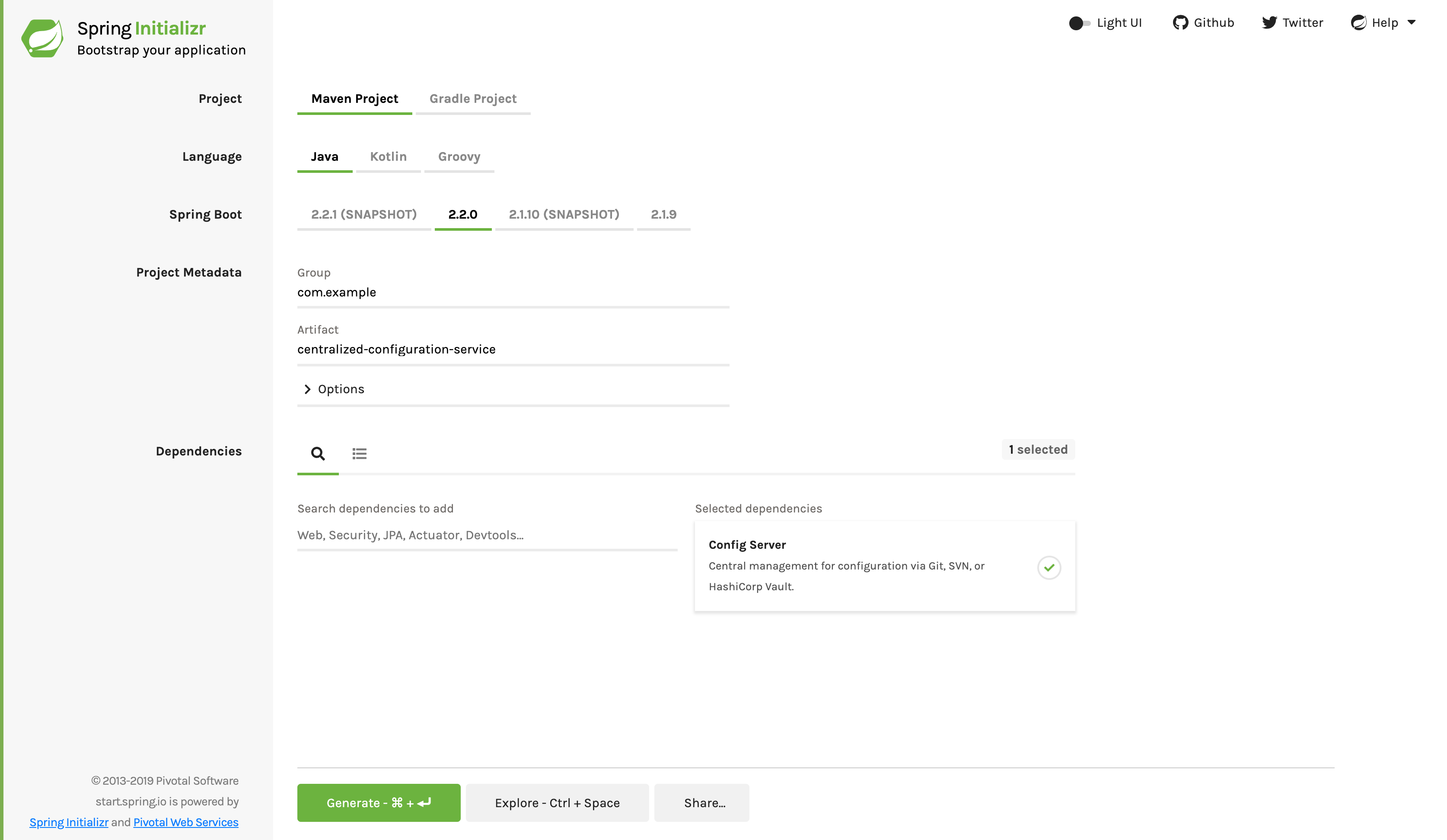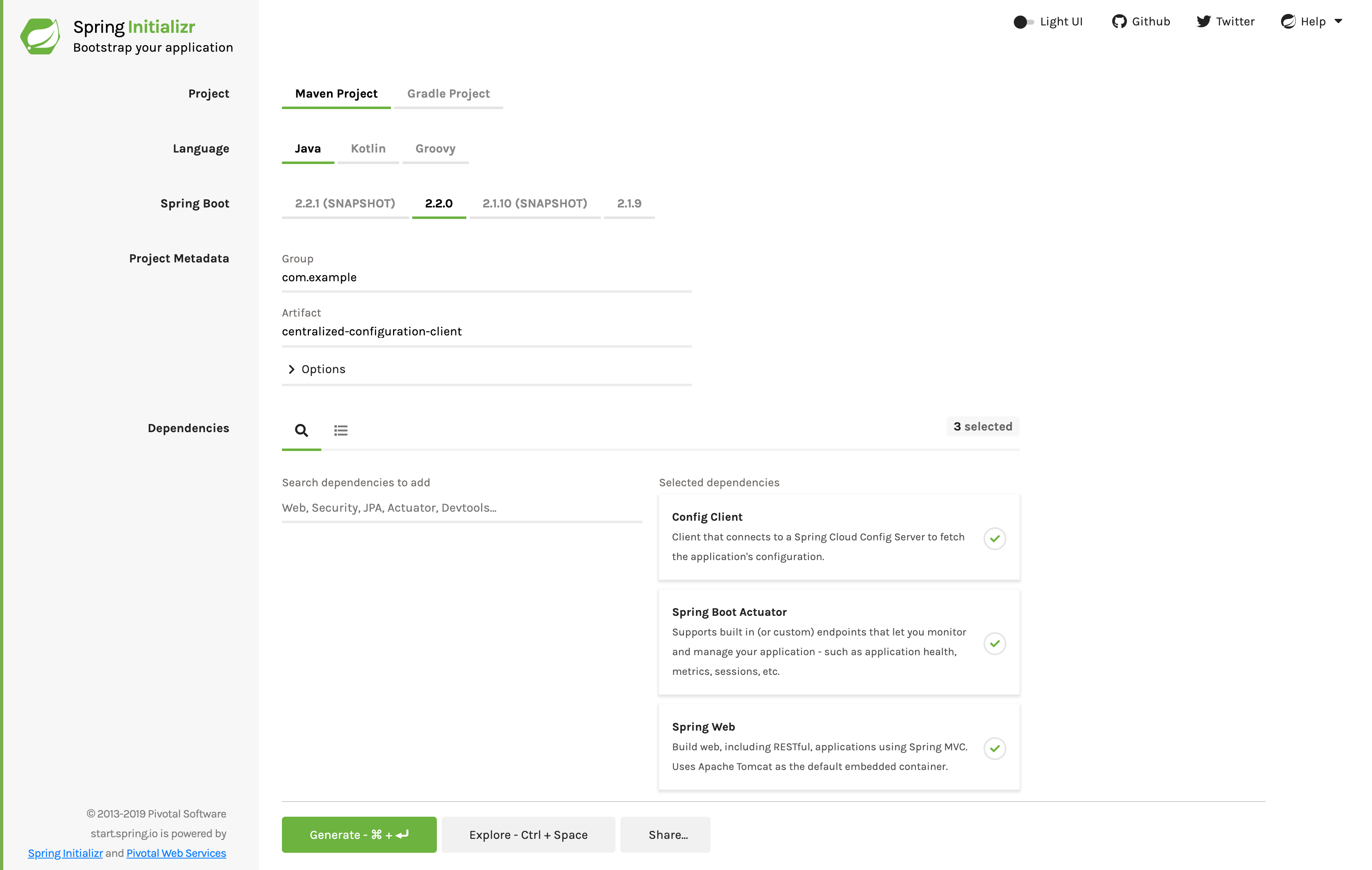This guide walks you through the process of standing up and consuming configuration from the Spring Cloud Config Server
You will set up a Config Server and build a client that consumes the configuration on startup and then refreshes the configuration without restarting the client.
For all Spring applications, you should start with the Spring Initializr. The Initializr offers a fast way to pull in all the dependencies you need for an application and does a lot of the set up for you.
This guide needs two applications. The first application (the configuration service) needs only the Config Server dependency. The following image shows the Initializr set up for the configuration service:
|
Note
|
The preceding image shows the Initializr with Maven chosen as the build tool. You
can also use Gradle. It also shows values of com.example and
centralized-configuration-service as the Group and Artifact, respectively. You will use
those values throughout the rest of this sample.
|
The following listing shows the pom.xml file (for the configuration service) that was
created when you choose Maven:
link:complete/configuration-service/pom.xml[role=include]
The following listing shows the build.gradle file (for the configuration service) that
was created when you choose Gradle:
link:complete/configuration-service/build.gradle[role=include]
The second application (the configuration client) needs the Config Client, Spring Boot Actuator, and Spring Web dependencies. The following image shows the Initializr set up for the configuration client:
|
Note
|
The preceding image shows the Initializr with Maven chosen as the build tool. You
can also use Gradle. It also shows values of com.example and
centralized-configuration-client as the Group and Artifact, respectively. You will use
those values throughout the rest of this sample.
|
The following listing shows the pom.xml file (for the configuration client) that was
created when you choose Maven:
link:complete/configuration-client/pom.xml[role=include]
The following listing shows the build.gradle file (for the configuration client) that
was created when you choose Gradle:
link:complete/configuration-client/build.gradle[role=include]
|
Note
|
For convenience, we have provided build files (a pom.xml file and a build.gradle
file) at the top of the project (one directory above the client and service directories)
that you can use to build both projects at once. We also added the Maven and Gradle
wrappers there.
|
You first need a Config Service to act as a sort of intermediary between your Spring
applications and a (typically) version-controlled repository of configuration files. You
can use Spring Cloud’s @EnableConfigServer to standup a config server that can
communicate with other applications. This is a regular Spring Boot application with one
annotation added to enable the config server. The following listing (from
configuration-service/src/main/java/com/example/configurationservice/ConfigurationServiceApplication.java)
shows such an application:
link:complete/configuration-service/src/main/java/com/example/configurationservice/ConfigurationServiceApplication.java[role=include]The Config Server needs to know which repository to manage. There are several choices
here, but start with a Git-based filesystem repository. You could as easily point the
Config Server to a Github or GitLab repository. On the file system, create a new directory
and run git init in it. Then add a file called a-bootiful-client.properties to the Git
repository. Then run git commit in it. Later, you will connect to the Config Server with
a Spring Boot application whose spring.application.name property identifies it as
a-bootiful-client to the Config Server. This is how the Config Server knows which set of
configuration to send to a specific client. It also sends all the values from any file
named application.properties or application.yml in the Git repository. Property keys
in more specifically named files (such as a-bootiful-client.properties) override those
in application.properties or application.yml.
Add a simple property and value (message = Hello world) to the newly created
a-bootiful-client.properties file and then git commit the change.
Specify the path to the Git repository by specifying the
spring.cloud.config.server.git.uri property in
configuration-service/src/main/resources/application.properties. You must also specify a
different server.port value to avoid port conflicts when you run both this server and
another Spring Boot application on the same machine. The following listing (from
configuration-service/src/main/resources/application.properties) shows such an
application.properties file:
link:complete/configuration-service/src/main/resources/application.properties[role=include]This example uses a file-based git repository at ${HOME}/Desktop/config. You can create
one easily by making a new directory and running git commit on the properties and YAML
files in it. The following set of commands does this work:
$ cd ~/Desktop/config
$ find .
./.git
...
./application.ymlOr you could use a remote git repository (such as Github) if you change the configuration file in the application to point to that instead.
Now that you have stood up a Config Server, you need to stand up a new Spring Boot
application that uses the Config Server to load its own configuration and that refreshes
its configuration to reflect changes to the Config Server on-demand, without restarting
the JVM. To do so, add the org.springframework.cloud:spring-cloud-starter-config
dependency, to connect to the Config Server. Spring sees the configuration property files,
as it would any property file loaded from application.properties or application.yml or
any other PropertySource.
The properties to configure the Config Client must necessarily be read in before the
rest of the application’s configuration is read from the Config Server, during the
bootstrap phase. Specify the client’s spring.application.name as a-bootiful-client
and the location of the Config Server (spring.cloud.config.uri) in
configuration-client/src/main/resources/bootstrap.properties, where it will be loaded
earlier than any other configuration. The following listing shows that file:
configuration-client/src/main/resources/bootstrap.properties
link:complete/configuration-client/src/main/resources/bootstrap.properties[role=include]You also want to enable the /refresh endpoint, to demonstrate dynamic configuration
changes. The following listing (from
configuration-client/src/main/resources/application.properties) shows how to do so:
link:complete/configuration-client/src/main/resources/application.properties[role=include]The client can access any value in the Config Server by using the traditional mechanisms
(such as @ConfigurationProperties or @Value("${…}") or through the Environment
abstraction). Now you need to create a Spring MVC REST controller that returns the
resolved message property’s value. See the
Building a RESTful Web Service guide to learn
more about building REST services with Spring MVC and Spring Boot.
By default, the configuration values are read on the client’s startup and not again. You
can force a bean to refresh its configuration (that is, to pull updated values from the
Config Server) by annotating the MessageRestController with the Spring Cloud Config
@RefreshScope and then triggering a refresh event. The following listing (from
configuration-client/src/main/java/com/example/configurationclient/ConfigurationClientApplication.java)
shows how to do so:
link:complete/configuration-client/src/main/java/com/example/configurationclient/ConfigurationClientApplication.java[role=include]You can test the end-to-end result by starting the Config Service first and then, once it
is running, starting the client. Visit the client app in the browser at
http://localhost:8080/message. There, you should see Hello world in the response.
Change the message key in the a-bootiful-client.properties file in the Git repository
to something different (Hello Spring!, perhaps?). You can confirm that the Config Server
sees the change by visiting http://localhost:8888/a-bootiful-client/default. You need to
invoke the refresh Spring Boot Actuator endpoint in order to force the client to refresh
itself and draw in the new value. Spring Boot’s Actuator exposes operational endpoints
(such as health checks and environment information) about an application. To use it, you
must add org.springframework.boot:spring-boot-starter-actuator to the client
application’s classpath. You can invoke the refresh Actuator endpoint by sending an
empty HTTP POST to the client’s refresh endpoint:
http://localhost:8080/actuator/refresh. Then you can confirm it worked by visting the
http://localhost:8080/message endpoint.
The following command invokes the Actuator’s refresh command:
$ curl localhost:8080/actuator/refresh -d {} -H "Content-Type: application/json"|
Note
|
We set management.endpoints.web.exposure.include=* in the client application to
make this is easy to test (since Spring Boot 2.0, the Actuator endpoints are not exposed
by default). By default, you can still access them over JMX if you do not set the flag.
|
Congratulations! You have just used Spring to centralize configuration for all of your services by first standing up a service and then dynamically updating its configuration.

